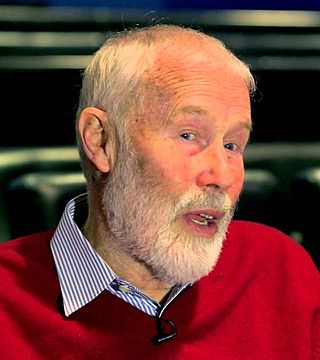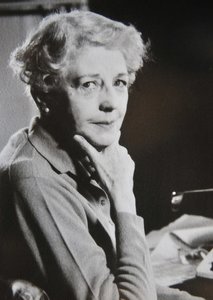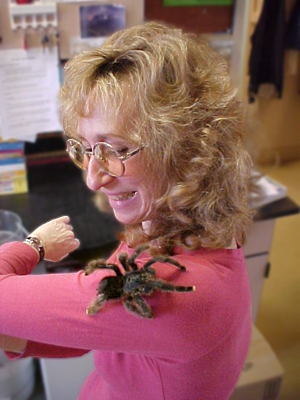Robert Philip Temple ONZM (born 1939 in Yorkshire, England) is a Dunedin-based New Zealand author of novels, children's stories, and non-fiction. His work is characterised by a strong association with the outdoors and New Zealand ecology. [1]
Robert Philip Temple ONZM (born 1939 in Yorkshire, England) is a Dunedin-based New Zealand author of novels, children's stories, and non-fiction. His work is characterised by a strong association with the outdoors and New Zealand ecology. [1]
Temple's early work was non-fiction, describing mountaineering expeditions to New Guinea and New Zealand and includes Nawok! (1962), Castles in the Air: Men and Mountains in New Zealand (1969), The Sea and the Snow: The South Indian Ocean Expedition to Heard Island (1966), and The World at Their Feet (1973).
Following this he produced a number of novels - The Explorer (1975), Stations (1979), Beak of the Moon (1981), Sam (1984), Dark of the Moon (1993), and To Each His Own (1999) - and many children's books, among which the most notable are The Legend of the Kea (1986), Kakapo, Parrot of the Night (1988), and Kotuku, Flight of the White Heron (1994). In 1980. Temple held the Robert Burns Fellowship at the University of Otago.
More recently, Temple has turned to an autobiographical relation of his own mountaineering adventures (The Last True Explorer (2002)) and a history of the Wakefield clan in New Zealand (A Sort of Conscience: The Wakefields (Auckland University Press, 2002), which won the Ernest Scott History Prize in 2003, the Ian Wards Prize for Historical Writing in 2003, and the Biography category of the 2003 Montana New Zealand Book Awards. He was also awarded the 2003 Creative New Zealand Berlin Writers' Residency [2] and the 2005 Prime Minister’s Awards for Literary Achievement in non-fiction. [3]

The kea is a species of large parrot in the family Strigopidae that is endemic to the forested and alpine regions of the South Island of New Zealand. About 48 cm (19 in) long, it is mostly olive-green, with brilliant orange under its wings and has a large, narrow, curved, grey-brown upper beak. Its omnivorous diet consists mainly of roots, leaves, berries, nectar, and insects, but also includes carrion. It was once killed for bounty due to concern by sheep-farmers that it attacked livestock, especially sheep. The kea is now uncommon, and received absolute protection under the Wildlife Act in 1986.

The kākāpō, sometimes known as the owl parrot or owl-faced parrot, is a species of large, nocturnal, ground-dwelling parrot of the superfamily Strigopoidea. It is endemic to New Zealand.

Sir Christian John Storey Bonington, CVO, CBE, DL is a British mountaineer.
Peter Boardman was an English mountaineer and author. He is best known for a series of bold and lightweight expeditions to the Himalayas, often in partnership with Joe Tasker, and for his contribution to mountain literature. Boardman and Tasker died on the North East Ridge of Mount Everest in 1982. The Boardman Tasker Prize for Mountain Literature was established in their memory.

The New Zealand kākā is a large species of parrot of the family Strigopidae found in New Zealand's native forests across the three main Islands of New Zealand. The species is often known by the abbreviated name kākā, although it shares this name with the recently extinct Norfolk kākā and Chatham kākā. Two subspecies of New Zealand kākā are recognised. It is endangered and has disappeared from much of its former range, though the re-introduction of North Island kākā at Zealandia in Wellington has led to an increasing population of the birds across the city.

Hamish MacInnes was a Scottish mountaineer, explorer, mountain search and rescuer, and author. He has been described as the "father of modern mountain rescue in Scotland". He is credited with inventing the first all-metal ice-axe and an eponymous lightweight foldable alloy stretcher called MacInnes stretcher, widely used in mountain and helicopter rescue. He was a mountain safety advisor to a number of major films, including Monty Python and the Holy Grail,The Eiger Sanction and The Mission. His 1972 International Mountain Rescue Handbook is considered a manual in the mountain search and rescue discipline.

Norah Ethel Lofts was a 20th-century British writer. She also wrote under the pen names Peter Curtis and Juliet Astley. She wrote more than fifty books specialising in historical fiction, but she also wrote some mysteries, short stories and non-fiction. Many of her novels, including her Suffolk Trilogy, follow the history of specific houses and their residents over several generations.

Eric Earle Shipton, CBE, was an English Himalayan mountaineer.
Hodder & Stoughton is a British publishing house, now an imprint of Hachette.

Dr John Connolly is an Irish writer who is best known for his series of novels starring private detective Charlie Parker.

Peter Edmund Hillary is a New Zealand mountaineer and philanthropist. He is the son of Sir Edmund Hillary, who, along with mountaineer Tenzing Norgay, completed the first successful ascent of Mount Everest. When Peter Hillary summited Everest in 1990, he and his father were the first father/son duo to achieve the feat. Hillary has achieved two summits of Everest, an 84-day trek across Antarctica to the South Pole, and an expedition guiding astronaut Neil Armstrong to land a small aircraft at the North Pole. He has climbed many of the world's major peaks, and on 19 June 2008, completed the Seven Summits, reaching the top of the highest mountains on all seven continents, when he summited Denali in Alaska.

Nicholas John Estcourt was a British mountaineer and alpinist who was killed in an avalanche on the West Ridge of K2.

Parrots (Psittaciformes), also known as psittacines, are birds with a strong curved beak, upright stance, and clawed feet. They are classified in four families that contain roughly 410 species in 101 genera, found mostly in tropical and subtropical regions. The four families are the Psittaculidae, Psittacidae, Cacatuoidea (cockatoos), and Strigopidae. One-third of all parrot species are threatened by extinction, with a higher aggregate extinction risk than any other comparable bird group. Parrots have a generally pantropical distribution with several species inhabiting temperate regions as well. The greatest diversity of parrots is in South America and Australasia.
George Kenneth Saunders (1910–2005), also known as Ken Saunders, was a New Zealand writer, born in England, who had a substantial career in Australia.

Sy Montgomery is an American naturalist, author, and scriptwriter who writes for children as well as adults.

John Dobrée Pascoe was a New Zealand mountaineer, photographer, writer, editor, historian and archivist.

Lingtren, 6,749 metres (22,142 ft), is a mountain in the Mahalangur Himal area of Himalaya, about 8 kilometres (5.0 mi) distant in a direct line from Mount Everest. It lies on the international border between Nepal and the Tibet Autonomous Region of China and it was first climbed in 1935. A mountain nearby to the west was originally named Lingtrennup but is now more commonly called Xi Lingchain.
Graham John Billing was a New Zealand novelist, journalist and poet. He was born in Dunedin, and educated at the Otago Boys' High School and the University of Otago where his father was professor of economics.
James Maurice Scott was a British explorer and writer. He was born in Egypt where his father was an English judge in the mixed courts. After he graduated from Cambridge University in 1928 he joined an exploring expedition to Labrador. He served in the 5th Scots Guard Ski Battalion.He is best known for his biography of Gino Watkins, and for the novel Sea-Wyf and Biscuit (1955) which was filmed as Sea Wife in 1957 starring Richard Burton and Joan Collins.
Audrey Salkeld was an English mountaineer, historian, and author. She reviewed and documented the contents of the archives of the early expeditions to Everest, including researching George Mallory and the events behind his death. That lead to her involvement in several books relating to Everest including The Mystery of Mallory and Irvine and Last Climb.